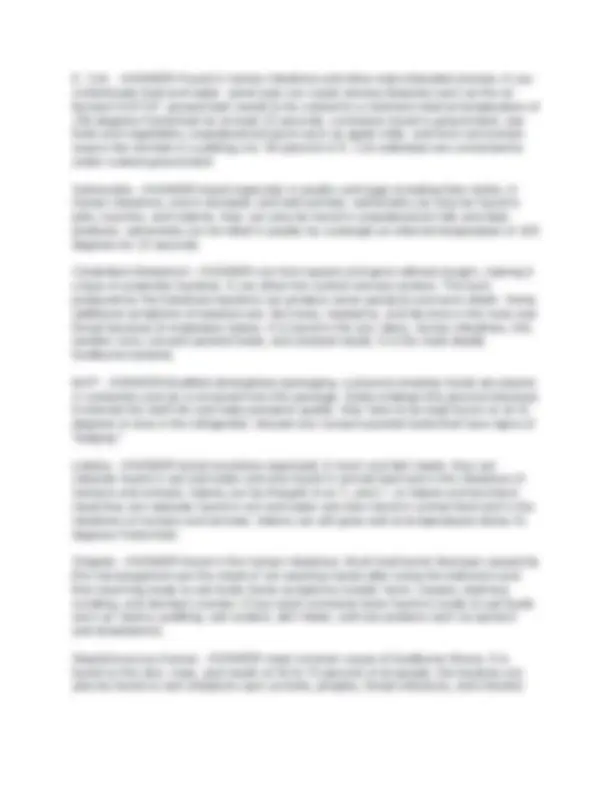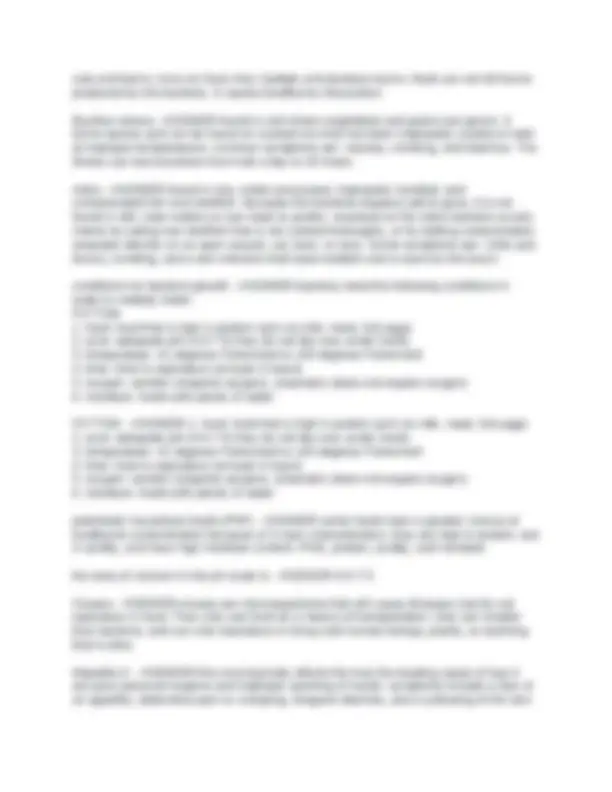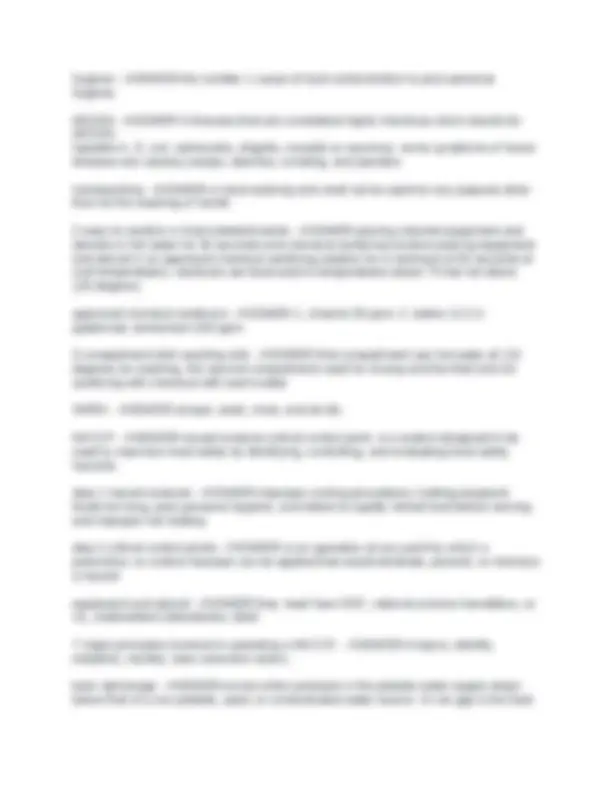







Study with the several resources on Docsity

Earn points by helping other students or get them with a premium plan


Prepare for your exams
Study with the several resources on Docsity

Earn points to download
Earn points by helping other students or get them with a premium plan
Community
Ask the community for help and clear up your study doubts
Discover the best universities in your country according to Docsity users
Free resources
Download our free guides on studying techniques, anxiety management strategies, and thesis advice from Docsity tutors
A comprehensive overview of food safety and sanitation principles, covering key areas like foodborne illness, contamination sources, and the fattom factors. It includes detailed explanations of various bacteria, viruses, and parasites associated with foodborne illnesses, along with their characteristics, sources, and prevention methods. The document also features a series of questions and answers, making it a valuable resource for students and professionals in the food industry.
Typology: Exams
1 / 9

This page cannot be seen from the preview
Don't miss anything!






2 bacteria associated with foodborne intoxication - ANSWER-staphylococcus aureus and clostridium botulinum. 3 main areas of food safety and sanitation - ANSWER-1. time and temperature
cross contamination - ANSWER-is the transfer of pathogens or disease causing micro organisms from one food to another. Symptoms of Food borne illness - ANSWER-cramping in the abdominal area, vomiting, nausea, diarrhea, fever, and dehydration. 2 foodborne illness - ANSWER-1. infection
cuts and burns. once on food, they multiply and produce toxins. Heat can not kill toxins produced by this bacteria. It causes foodborne intoxication Bacillus cereus - ANSWER-found in soil where vegetables and grains are grown. it forms spores and can be found on cooked rice that has been improperly cooled or held at improper temperatures. common symptoms are: nausea, vomiting, and diarrhea. The illness can last anywhere from half a day to 24 hours. vibrio - ANSWER-found in raw, under processed, improperly handled, and contaminated fish and shellfish. because this bacteria requires salt to grow, it is not found in still, clear waters or raw meat or poultry. exposure to the vibrio bacteria occurs mainly by eating raw shellfish that is not cooked thoroughly, or by betting contaminated seawater directly on an open wound, cut, burn, or sore. Some symptoms are: chills and fevers, vomiting, and a skin infection that looks reddish and is warm to the touch. conditions for bacteria growth - ANSWER-bacteria need the following conditions in order to multiply faster: FATTOM
or whites of the eyes. The symptoms can appear in 14 days and last as long as 6 weeks. norwalk/ Norovirus - ANSWER-large amount of viral illnesses. it lives in the human intestinal tract. transmitted through a fecal-oral route or vomit-oral route. Parasites - ANSWER-are organisms that live within or feed off another organism or host. they are larger than bacteria, but can be very small too. trichinella - ANSWER-roundworm found in pork that produces trichinosis.. pigs are the main carriers of this parasite. we can kill trichinella by cooking pork to 145 degrees Fahrenheit for 15 seconds. it is transferred by way of circulatory system, heart and blood stream. system include vomiting, fever, headaches, eye swelling, aching joints, and even death. Parasites can be killed if the food is cooked well or frozen at minus 4 degrees for 7 days or minus 31 degrees for 15 hours. anisakis - ANSWER-parasite found in fish and seafood that produces anisakiasis. symptoms are a tickling or tingling sensation in the throat causing the person to cough up the actual parasite. cook fish to 145 degrees. Giardia - ANSWER-parasite that is found mostly in bodies of contaminated water throughout the entire world, making it one of the most common sources of waterborne illness. ciguatera - ANSWER-is a type of seafood poisoning. the cause is not the fish, but what the fish eats. scombroid poisoning - ANSWER-is the most common reported cause of seafood illness. it comes from histamine toxins which require anti-histamines for treatment. toxins are produced when fish like mahi mahi began to spoil from being time and temperature abused. It is mainly associated with time and temperature abuse chemical contamination - ANSWER-is caused when substances such as cleaning compounds, acids, detergents, soaps, chemicals, and pesticides get into food. it can occur in nature physical contamination - ANSWER-is caused when hair, glass, metal shavings, broken objects, rocks, etc gets into food. In other words, if you can see it, then it can be possible physical contamination mold - ANSWER-can cause allergic reactions and illness of a respiratory nature in people from high risk populations groups. it can be killed by heating foods to 140 degrees for 10 minutes, but it will not destroy their toxins if they have been produced and and one may still experience illness. freezing prevents growth of molds, but has no effect on the mold spores that are already present in the food.
how to check for poultry - ANSWER-look for a fresh smell and temperature at 41 degrees or less. should be placed on crush ice. how to check for seafood - ANSWER-fish should be delivered and stored in crushed ice. fresh fish has bright skin, gills that are moist and red, and scales firmly attached. eyes must be clear and bulging. flesh must be firm and elastic. how to check for shellfish - ANSWER-fresh shellfish must be alive when delivered, and should not have a strong odor. shell stock id tags must be saved for 90 days. it must be received at 45 degrees or below. do not eat shellfish during red tide. how to check eggs - ANSWER-they have to be received at 45 degrees or less, however receiving the eggs at a lower temperature is recommended. it must be pasteurized and required for recipes that need none or little cooking frozen foods - ANSWER-keep all foods between 0-and minus 10 degrees. do not thaw and refreeze foods. only refreeze if the product is cooked dairy - ANSWER-milks products that are served without being pasteurized should never be consumed. milk and dairy products must be pasteurized, grad a, and must be received under 41 degrees. dry foods - ANSWER-look for punctures, tears, holes, or slashing in the packages. fruits and vegetables - ANSWER-the best indication of quality is taste. all produce must be thoroughly washed in clean potable water before serving. juices of fruits and vegetables should be pasteurized. allergies - ANSWER-on January 1, 2006 the federal drug administration required food labels to state if any ingredients contained protein from the eight major allergenic foods. this was a result of the food allergen labeling and consumer act of 2004 or FALCPA. the 8 major allergenic foods are: milk, eggs, fish shellfish, nuts derived from a tree, soybeans, wheat, and peanuts. one major symptom is anaphylactic shock, which can includ hives, the tightness of throat, itching, swelling, and even death food sanitation 101 - ANSWER-the safety of the consumer should be your first concern. safety includes the facility itself, the food you serve, and the employees who are under your supervision. the most common reason for foodborne illness is inadequate cooling and poor refrigeration preparing foods - ANSWER-the employees health, personal hygiene, and hand washing is important. prevention is the best way to avoid foodborne illnesses FIFO - ANSWER-the most important rule for storage is first in first out. this means that food has to be used in the order in which it is received
hygiene - ANSWER-the number 1 cause of food contamination is poor personal hygiene. HESSN - ANSWER-5 illnesses that are considered highly infectious which stands for HESSN: hepatitis A, E. coli, salmonella, shigella, norwalk or norovirus. some symptoms of hessn illnesses are nausea,cramps, diarrhea, vomiting, and jaundice handwashing - ANSWER-a hand washing sink shall not be used for any purpose other than for the washing of hands 2 ways to sanitize in food establishments - ANSWER-placing cleaned equipment and utensils in hot water for 30 seconds and chemical sanitizing involves placing equipment and utensil in an approved chemical sanitizing solution for a minimum of 60 seconds at cool temperatures. sanitizers are best used in temperatures above 75 but not above 120 degrees. approved chemical sanitizers - ANSWER-1. chlorine 50 ppm. 2. iodine 12.5 3. quaternary ammonium 200 ppm 3 compartment dish washing sink - ANSWER-first compartment use hot water at 110 degrees for washing, the second compartment used for rinsing and the third sink for sanitizing with chemical with warm water SWRA - ANSWER-scrape, wash, rinse, and air dry HACCP - ANSWER-hazard analysis critical control point. is a system designed to be used to maximize food safety by identifying, controlling, and evaluating food safety hazards. step 1 hazard analysis - ANSWER-improper cooling procedures, holding prepared foods too long, poor personal hygiene, and failure to rapidly reheat food before serving and improper hot holding step 2 critical control points - ANSWER-is an operation at any point by which a preventive, or control measure can be applied that would eliminate, prevent, or minimize a hazard equipment and utensil - ANSWER-they must have NSF, national science foundation, or UL, underwriters laboratories, label 7 major principles involved in operating a HACCP. - ANSWER-Analyze, identify, establish, monitor, take correction action, back siphonage - ANSWER-occurs when pressure in the potable water supply drops below that of a non potable, used, or contaminated water source. An air gap is the best